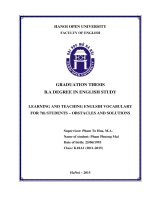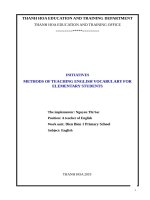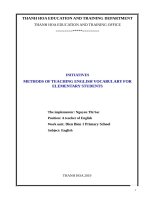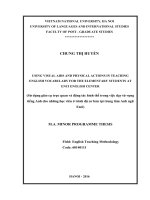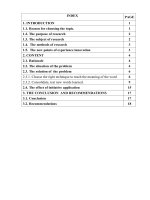APPLICATION OF BEHAVIORAL LEARNING THEORY IN TEACHING ENGLISH VOCABULARY FOR THE STUDENTS AT BAC HONG PRIMARY SCHOOL IN HANOI
Bạn đang xem bản rút gọn của tài liệu. Xem và tải ngay bản đầy đủ của tài liệu tại đây (770.29 KB, 106 trang )
PHẠM THỊ LÀNH
VIETNAM ACADEMY OF SOCIAL SCIENCES
GRADUATE ACADEMY OF SOCIAL SCIENCES
Phạm Thị Lành
ENGLISH LANGUAGE
APPLICATION OF BEHAVIORAL LEARNING
THEORY
COVER PAGE
2
IN TEACHING ENGLISH
VOCABULARY FOR THE STUDENTS AT BAC
HONG PRIMARY SCHOOL IN HANOI
MA THESIS IN ENGLISH LANGUAGE
COURSE: 2017 – 2019
HANOI, 2019
VIETNAM ACADEMY OF SOCIAL SCIENCES
GRADUATE ACADEMY OF SOCIAL SCIENCES
Phạm Thị Lành
APPLICATION OF BEHAVIORAL LEARNING
THEORY IN TEACHING ENGLISH
VOCABULARY FOR THE STUDENTS AT BAC
HONG PRIMARY SCHOOL IN HANOI
Field: English Language
Code: 8220201
Supervisor: Assoc. Prof. Dr. Hồ Ngọc Trung
HANOI, 2019
DECLARATION BY AUTHOR
I, the undersigned, hereby certify that the thesis entitled “Application
of behavioral learning theory in teaching English vocabulary for the
students at Bac Hong primary school in Hanoi” is the result of my own
research for the Degree of Master of Arts in English Language. The
substance of the thesis has not, wholly or in part, been submitted for any
other degree to any other universities or institutions.
Except where reference has been made in the text, this thesis contains
no material previously published or written by another person.
The study reported in this thesis was approved by Graduate Academy
of Social Sciences.
Author’s Signature
Phạm Thị Lành
Approved by
SUPERVISOR
Assoc. Prof. Dr. Hồ Ngọc Trung
Date: August 16th, 2019
i
ACKNOWLEDGEMENTS
I would like to express my sincere gratitude and deep appreciation to
Assoc. Prof. Dr. Hồ Ngọc Trung, my supervisor, for his helpful and warm
encouragement as well as his insightful comments on my work from the
beginning to the end of my study. In addition, many thanks go to the teachers
at the Faculty of Foreign Languages, GASS, for their interesting lessons
from which I have benefited a lot for the accomplishment of the thesis.
The completion of this thesis would not have been possible without the
cooperation from the respondents (84 students from the fifth grade at Bac
Hong primary school in Hanoi) who have been willing to take part in the
study. I am very grateful to all of them for providing detailed information for
the analysis of this study.
I also offer my special thanks to my colleagues and friends whose
support and encouragement help me to have this thesis accomplished.
Last but not least, I am greatly indebted to my family for their
patience, endless love, and devotion. Whatever choices I have made, they
have always stood by me and believed in me. I am immensely thankful for all
the assistance they have given me.
ii
TABLE OF CONTENTS
DECLARATION BY AUTHOR .............................................................................................. i
ACKNOWLEDGEMENTS ..................................................................................................... ii
TABLE OF CONTENTS ........................................................................................................ iii
ABSTRACT ............................................................................................................................ viii
LIST OF TABLES ................................................................................................................... ix
LIST OF FIGURES .................................................................................................................. x
LIST OF ABBREVIATIONS ................................................................................................. xi
CHAPTER 1: INTRODUCTION............................................................................................ 1
1.1. Rationale .............................................................................................. 1
1.2. Aim(s) of the Study .............................................................................. 3
1.3. Research Questions ............................................................................. 3
1.4. Scope of the Study ............................................................................... 3
1.5. Significance of the Study ..................................................................... 4
Hopefully, the study will make a small contribution to the application of
behaviorism in improving the young students’ vocabulary at Bac Hong
primary school in Dong Anh, Hanoi. ......................................................... 4
1.6. Research Methods ............................................................................... 4
1.7. Structure of the Study ......................................................................... 4
CHAPTER 2: LITERATURE REVIEW ............................................................................... 6
2.1. An overview of behaviorism.................................................................. 6
2.1.1. Concept of behaviorism................................................................ 6
2.1.2. Behaviorism's point of view and foreign language teaching
methodology .......................................................................................... 8
2.2. The primary school learners ................................................................ 10
2.2.1. Characteristics ............................................................................ 10
2.2.2. Cognitive development............................................................... 11
iii
2.3. Teaching vocabulary for primary school students ................................ 13
Obviously, vocabulary is very important in learning a language,
especially in learning English, because the English vocabulary is
extremely large and varies as well. According to El-Koumy (2004, p.
40), vocabulary is an essential component of language and we would be
totally mistaken if we ignore teaching it. .............................................. 13
2.3.1. Concept of vocabulary................................................................ 14
2.3.2. The role of vocabulary in language teaching and learning .......... 14
2.3.3. Teaching English vocabulary effectively .................................... 15
2.4. Vocabulary teaching activities based on behavioral learning theory .... 17
2.4.1. General concept of TPR ............................................................. 17
2.4.2. Characteristics of TPR................................................................ 18
Total physical response (TPR) helps students to understand the target
language as a whole rather than the rules of the language. For example,
to explain particular word such pen, the teacher holds up a book and say
“this is a pen” and repeated by the students. This method is closely
related with Grammar Translation Method which uses translation
method to explain a language to students but instead of telling the
meaning, the teacher gives a clue (picture, gesture) and let the students
to figure by themselves. ....................................................................... 18
2.4.3. Procedures of TPR ..................................................................... 19
2.4.4. TPR activities used for primary school learners in the study ..... 21
2.5. Previous studies ................................................................................... 24
2.6. Summary ............................................................................................ 28
iv
CHAPTER 3: METHODOLOGY ........................................................................................ 29
3.1. Research setting................................................................................... 29
3.1.1. Context of the study ................................................................... 29
3.1.2. Definition of experimental research............................................ 31
3.1.3. Steps of an Experimental research .............................................. 32
3.2. Participants .......................................................................................... 33
3.2.1. The Researcher ........................................................................... 33
3.2.2. The Students............................................................................... 34
3.3. Data collection instruments ................................................................. 35
3.3.1. Pre- test ...................................................................................... 35
3.3.2. Post test ...................................................................................... 36
3.3.3. Classroom observation ............................................................... 37
3.3.4. Questionnaires ........................................................................... 38
3.4. Research design .................................................................................. 40
3.5. Procedures ........................................................................................... 42
3.5.1. Experiment Group ...................................................................... 42
3.5.2 Control Group ............................................................................. 43
3.6. Methods of data analysis ..................................................................... 44
Students' score =........................................................................................ 44
total number of correct answers .................................................................. 44
3.7. Summary ............................................................................................. 45
CHAPTER 4: FINDINGS AND DISCUSSIONS ................................................................. 46
4.1. Data analysis from the tests ................................................................ 46
v
4.1.1. The Scores and Analysis of the Experiment Group ................... 46
4.1.3. The comparison of the mean scores between two groups ........... 49
4.2. Students’ Response from Classroom Observation ............................... 50
4.2.1. Experiment Group ...................................................................... 50
4.2.2. Control Group ............................................................................ 51
4.3. Data Analysis from Questionnaires ..................................................... 51
4.3.1. Analysis of the first questionnaire .............................................. 52
4.3.2. Analysis of the second questionnaire ........................................ 56
4.4. Discussion ........................................................................................... 61
CHAPTER 5: CONCLUSION .............................................................................................. 63
In this chapter, we summarize the study and the research findings. Then, we
would like to discuss the applications, the limitations of this study, and the
further studies. ......................................................................................... 63
5.1. Recapitulation ................................................................................... 63
The experimental research project was carried out in optional lessons during
4 months in the second semester of school year 2018 -2019 of eighty -four
students in class 5A and 5B at Bac Hong primary school. The previous
chapters show that using TPR method that implied from behavioral
learning theory in English vocabulary lessons consumed a lot of time.
Most of the students had few opportunities to be taught with TPR
activities. However, from the author's experience in teaching English with
TPR method, two types of lessons and class observation can be drawn for
experiment group and control group. First, TPR method can be used
effectively for experiment group to develop student's English vocabulary.
Second, traditional method is conducted to use for control group in
vi
learning English vocabulary. After that, we compare the results of the two
groups to find the differences between them. ........................................... 63
5.2. Concluding Remarks ........................................................................... 64
5.3. Implications ......................................................................................... 66
5.4. Limitations and Suggestions for Further Studies.................................. 67
5.4.1. Limitations ................................................................................. 67
5.4.2. Suggestions for Further Studies ................................................ 68
REFERENCES........................................................................................................................... I
Foreign Authors ......................................................................................................................... I
Pinter, A. (2006). Teaching Young Language Learners. Oxford, UK: Oxford
University Press....................................................................................................................... III
Vietnamese Authors ................................................................................................................ IV
APENDIX 1 ...............................................................................................................................V
First questionnaire - Questionnaire for both groups Direction ...................... V
APPENDIX 2 ........................................................................................................................ VIII
APPENDIX 3 ........................................................................................................................... XI
APPENDIX 4 ........................................................................................................................ XIII
POST TEST 1 ....................................................................................................................... XIII
APPENDIX 5 .......................................................................................................................... XV
APPENDIX 6 .......................................................................................................................XVII
APPENDIX 7 .......................................................................................................................... XX
APPENDIX 8 ......................................................................................................................XXII
Unit 13: WHAT DO YOU DO IN YOUR FREE TIME? ...............................................XXII
I. Objectives: By the end of this unit pupils can ..............................................................XXII
II. Languages focus: ............................................................................................................XXII
III. Teaching aids: ...............................................................................................................XXII
IV. Teaching processes: ......................................................................................................XXII
1. Class organization: ..........................................................................................................XXII
2. New lesson ........................................................................................................................XXII
vii
ABSTRACT
This study is conducted to investigate the the extent to which behavioral
learning-based activities facilitate vocabulary learning at Bac Hong Primary
School and the attitudes of the students towards using behavioral learningbased activities in vocabulary teaching and learning. There are 84 students
who are from class 5A and 5B at the school take part in this study. The study
lasted 4 months. A pre-test, 4 posttests, 2 questionnaires and class
observation are chosen as the data collection instruments of the experimental
research. Research findings showed that the students had positive attitudes
and progress in learning English vocabulary in the treatment group in which
the researcher applied TPR method based on behavioral learning theory
rather than in the control group. After analyzing and synthesizing the
statistics, the researcher discussed and recommended some implications
along with suggestions for further research. Last but not least, it is much
hoped that the results of the study could be useful for the development of
teaching and learning English vocabulary in particularly and all aspects of
this language in general at Bac Hong primary school.
viii
LIST OF TABLES
Page
Table 3.1: Frame of Questionnaire for 2 groups of students
47
Table 3.2: Frame of Questionnaire for students in experimental 49
group
Table 4.1: The scores of the experiment group
47
Table 4.2: The score of the control group
48
Table 4.3: Results of Questionnaire for 2 groups of students
52
Table 4.4: Results of Questionnaire for students in experimental 56
group
ix
LIST OF FIGURES
Page
Figure 4.1: Mean score of the two groups
x
49
LIST OF ABBREVIATIONS
EFL: English as a Foreign Language
TPR: Total Physical Response
ALM: Audio-lingual Method
GMT: Grammar Translation Method
LAD: Language Acquisition Device
xi
CHAPTER 1: INTRODUCTION
1.1. Rationale
There is no doubt that knowledge of a foreign language is nowadays
necessary. The ability to speak another language not only increases the
chance to get a decent job but it is also convenient for personal use – to make
oneself
understood
abroad.
As
today’s
international
language
for
communication is considered to be English, the demand for English speaking
people has rapidly increased. Due
to
its
great
importance,
English
language has become an obligatory school subject at all primary
schools in Vietnam. This means that the pupils are obliged to start learning
this foreign language at a very early age. Some of them, however, might be
exposed to English even earlier, though not mandatorily, since a lot of
kindergartens offer English classes. It is not easy to study perfect English
vocabulary. Almost all students often face up with some problems in learning
vocabulary at first, especially primary school students. In fact, it is difficult to
memorize a new word with its meaning, spelling and pronunciation, many
primary students are often confused with knowing how can apply grammar
into sentences, sometimes, they cannot understand when being opposed to
video and audio. Moreover, techniques to teach English in primary schools is
traditional teaching methods and similar activities days by days, which makes
students become fed up with learning English.
Therefore, English teaching for primary school children is especially
concerned by parents and society in our country. Interesting techniques to
teach English are necessary to help students learn English vocabulary better;
they also attract students' interest on English. To create a good condition of
learning English at school, teachers should give students opportunities to be
sensitive to this foreign language. Children develop the ability to use
1
language to understand others and to express their own meanings in the preschool years, and in the school years, this ability expands and grows. We
must bear in mind that children have different competences and abilities than
adult learners do.
In language learning, there are four major and familiar theories of
language acquisition and language learning named behaviorism, cognitivism,
humanism, and constructivism. Based on the historical development,
behaviorism is the first theory of that is presented by Skinner and Noam
Chomsky. Speaking simply, behaviorists’ view on learning shows how
learners’ behavior is shaped through stimulus and response. They also view
that behavior is observable.
In English Language Teaching, the teacher needs a method that is
suitable to teach children by considering their language acquisition. Actually,
children will learn easily when it is fun with movement and physical
participation. As teaching adults and teaching children are different, teachers
should choose the suitable method and act properly. Considering the problem
existed, it is believed that implementing an appropriate method to teach
children is necessary.
From the above reasons, we decide to conduct a research on
“Application of behavioral learning theory in teaching English vocabulary
for the students at Bac Hong primary school in Hanoi”. We hope to give
some small suggestions for English primary school teachers to choose
adequate teaching methods and classroom activities. It is necessary to hold
discussion of the theory of behaviorism. This research will briefly examine an
overview of behaviorism theory, how behaviorism theory is applied to a
particular method of English language teaching methodology, and to an
approach of teaching English vocabulary. Hopefully the discussion will result
2
in minimizing false assumptions about the theory of behaviorism
understanding of why teachers choose a particular method or technique of
teaching for particular learners with particular learning objectives.
1.2. Aim(s) of the Study
The study is aimed to examine the effectiveness of using activities
based on behavioral learning theory in teaching English-as-a-foreignlanguage vocabulary to primary school children.
In order to achieve the above aim, the study centres on:
- Investigating the extent to which behavioral learning-based activities
facilitate vocabulary learning at Bac Hong Primary School;
- Finding out the attitudes of the students towards using behavioral
learning-based activities in vocabulary teaching and learning.
1.3. Research Questions
The thesis addresses the following research questions:
- To what extent does the use of behavioral learning-based activities
facilitate vocabulary learning at Bac Hong Primary School?
- What do the students think about the use of behavioral learning-based
activities in vocabulary teaching and learning?
1.4. Scope of the Study
Within the shortage of time, experience, and references, my research
cannot cover all aspects of English teaching methods. It mainly focuses on
studying the primary children’s English acquisition influenced by
behaviorism and giving typical sample lessons in a period of 40 minutes for
grade 5 at Bac Hong Primary School (Dong Anh, Hanoi) where I am working
as a teacher of English.
3
1.5. Significance of the Study
Hopefully, the study will make a small contribution to the application
of behaviorism in improving the young students’ vocabulary at Bac Hong
primary school in Dong Anh, Hanoi.
1.6. Research Methods
The study was carried out by qualitative approach with the research
method of Experimental Research which analyzes and gives examples
behaviorism and its influence in teaching English as a foreign language for
young children. Comments, remarks, suggestions and conclusions are based
on problem identification, planning, actual researche, experience, and
discussions.
Preliminary survey was conducted in order to identify students’ initial
problems in English vocabulary.
Questionnaires were given to analyze the learners’ attitudes towards
teaching and learning English vocabulary based on behavioral learning theory
in the EFL classes.
1.7. Structure of the Study
The study consists of five chapters:
Chapter 1 – Introduction: give reasons for choosing the thesis, scope
and aims of the study as well as the research method and the structure of the
study.
Chapter 2 – Literature Review: This chapter focuses on an overview of
brief knowledge about the behaviorism theory in language acquisition,
analyzes the teaching methods and techniques that make use of the theory,
characteristics and cognitive development of young learners and teaching
English at primary school.
4
Chapter 3 - Methodology: This chapter reports the context settings,
research hypothesis, participants, instruments and the procedure of
conducting Experimental Research for the study. The detailed results of the
surveys and a critical comprehensive analysis on the data collected are
presented.
Chapter 4- Findings and Discussion: The part gives the data analysis
from the Experimental Research results to make the foundation for the
activities in chapter 5.
Chapter 5 – Conclusion: summarizes the study, suggestions some
typical activities and practical tips for teacher to improve 5 th -grade students’
English vocabulary and examples for illustration, limitations of the study and
suggestions for further study.
5
CHAPTER 2: LITERATURE REVIEW
This chapter is concerned with the conceptions of behaviorism, the
young learners' characteristics and cognitive development, teaching English
vocabulary at primary school, Total Physical Respond method and previous
studies on teaching English vocabulary for primary school children.
2.1. An overview of behaviorism
2.1.1. Concept of behaviorism
Behaviorism is a theory of learning that was influential in the 1940s
and 1950s, especially in the United States. With regard to language learning,
the best-known proponent of this psychological theory was B. F. Skinner
(1957). Traditional behaviorists hypothesized that when children imitated the
language produced by those around them, their attempts to reproduce what
they heard received ‘positive reinforcement’. This could take the form of
praise or just successful communication. Thus encouraged by their
environment, children would continue to imitate and practise these sounds
and patterns until they formed ‘habits’ of correct language use.
Behaviorism states that children learn a language mainly through
repetition, imitation and habit formation. Chomsky (1959) deviating from the
tenets of Behaviorism introduces the Innate Hypothesis. Chomsky (1993)
states that ‘Language learning is not really something that the child does; it is
something that happens to the child placed in an appropriate environment,
much as the child’s body grows and matures in a
predetermined way when
provided with appropriate nutrition and environmental stimulation’ (p. 519).
Behaviorism learning theory oriented "results that can be measured,
observed, analyzed, and tested objectively". Repetition and training are used
so that the desired behavior can become a habit. The expected result of the
application of the theory of behaviorism is the formation of a desired
6
behavior. Desired behavior gets positive reinforcement. Skinner (1976) noted
that evaluation or assessment is based on observed behavior. In this theory, a
lot of teachers do not lecture, but brief instructions are followed by examples,
either by themselves or through stimulation.
Behaviorism Learning Theory is a theory of learning that emphasizes
human behavior as a result of the interaction between stimulus and response.
Behaviorism theory is a theory proposed by Gage and Berliner. This theory
later developed into the flow of learning psychology that influence the
development of education and learning theory known as behaviorism flow.
This emphasis on the formation of the flow behavior appears to be a result of
learning.
According to Alissa (2003), behaviorism theory with stimulus-response
relationship model, seated person as an individual passive learning. Specific
behavioral responses analyzed by using training methods or habituation alone.
The emergence of behaviors will be stronger when given reinforcement and
will disappear when sentenced. A person is considered to have learned
something if he can show changes in behavior. According to this theory the
important learning is in the form of inputs and outputs in the form of stimulus
response.
Stimulus is all that is given by the teacher to the learner, while the
response in the form of student reactions or responses to the stimulus given by
the teacher.
Therefore, it is something given by the teacher (stimulus) and
something that is accepted by the students (response) should be observed and
measured (Fauziati, 2016). It focuses on the theory of measurement, since the
measurement is an important thing to notice changes in behavior occurs or
not.
7
2.1.2. Behaviorism's point of view and foreign language teaching
methodology
Behaviorism, one of the theories in Children Language Acquisition
which proposed by B.F. Skinner. Skinner (1976) stated that in this theory the
teacher emphasizes in giving instruction and examples, either by themselves
or through stimulation. In other words, by giving examples the children can
imitate and then reinforce what they get. To support the assumption, the
journal entitled “Behaviorism in Foreign Language Teaching Methodolody”
proves by explained and underlined that human behavior is a result of
stimulus and response (Budiman, 2017). Therefore, to help children learn a
language, the teacher does not lecture the children but rather offer commands
than lecturing.
There have been some well-known researchers whose work on kids’
language acquisition. Skinner studied habit formation in behaviorism. He
agreed that repetition can make pupils learn well. The Critical Period
Hypothesis is that there is a time in human development when the brain is
predisposed for success in language learning. It has been hypothesized that
there is a critical period for second language acquisition just as there is for
first language acquisition. Noam Chomsky explained the development of
language ability by innate language acquisition device. Chomsky theorized
that children were born with a hard-wired language acquisition device
(hereafter, LAD) in their brains (cited in Pinker, 1994). Pinker (1994) claimed
that LAD is a set of language learning tools, intuitive at birth in all children.
He also showed that each person has universal grammar.
Behaviorism theory is crucial in foreign language learning. The
influence of this theory can be seen in the close relation to a particular
8
language teaching method called Audio-lingual Method (ALM). This ALM
has two principles:
(1) Stimulus-Response concept, and
(2) an assumption that second language learning should reflect and
imitate the perceived process of mother tongue learning.
According to Fauziati (2016), the application of behaviorism theory in
Audio-lingual method is as follows:
(1) the organism is the learner,
(2) the behavior as verbal behavior,
(3) the stimulus as what is presented of the foreign language,
(4) the response as the learners’ reaction to the stimulus, and
(5)the reinforcement as the extrinsic approval and praise of the teacher,
fellow students, and self-satisfaction of target language use.
Based on the relation between behaviorism theory and ALM, it is clear
now that ALM is marked by the following characteristics:
(1) new language should always be dealt with in the sequence of
listening, speaking, reading, and writing with emphasis on teaching receptive
skills before productive skills, nothing will be spoken before it has been
heard, and nothing will be written before it has been read,
(2) habit formation through frequent repetition,
(3) errors are avoided,
(4) the use of dialogues as the chief means of presenting language,
(5) using mimicry, memorization, and pattern drills techniques,
(6) discouraging the use of mother tongue in the classroom, and
(7) the use of language lab in conducting teaching and learning process.
From that theory, young learner tends to remember better the language
when the learning process using and applying physical activities. Asher
9
(1977) showed that in learning the first language, before they speak, the
listening should be accompanied by physical responses like reaching,
grabbing, moving, or looking. This theory is familiar with the name of Total
Physical Response (TPR). It is assumed that Total Physical Response method
has the similar principle with behaviorist theory. The teacher’s direct here
means the instruction given by the teacher. Therefore, it can be concluded that
it is the stimulus they deliver to the children. Moreover, the students act is the
response of it. If the teacher gives the command and gives the example or be
the model, while the students copy what they did, it is similar with the theory
of imitation in behaviorism. Whereas the teacher gives the same command
over and over or repetition instruction, and makes the students habitual with
it, it is the application of behaviorist theory in correlation with TPR method.
For instance, in a lesson: Let say the topic is part of body. The teacher may
ask “repeat after me”, “touch your ear”, while pointing the ear and the
students should repeat what the teacher say and do. If the teacher does it
repeatedly and the students imitate it until they pronounce it well, so that the
method is successfully implemented.
2.2. The primary school learners
According to Vietnamese education, the primary school learners mean
children from the first year of formal schooling (six years old) to the fifth
grade (eleven years old).
2.2.1. Characteristics
In most of the literature dealing with teaching at primary level, children
are capable of using logical reasoning but they can also use their vivid
imagination. Their basic concepts are formed and they have very decided
views of the world. Children at this age do not see the teacher as an absolute
10
authority anymore. They are able to make some decisions about their own
learning and they begin to question the teacher’s decisions.
Young learners need to move, they have got huge amount of energy.
They tend to have short attention spans. Children are very much linked to
their surroundings and are more interested in the physical and the tangible.
According to Scott and Ytreberg (1995), children’s own understanding comes
through hands and eyes and ears and their physical world is dominant at all
times. Scott and Ytreberg (1995) concludes characteristics of children:
- The children ask questions all the time.
- They rely on both the spoken word and the physical representation of
the word to convey and understand meaning.
- They have definite views about what they like and do not like to do.
- They have developed sense of fairness about what happens in the
classroom and they begin to question the teachers’ decisions.
- They are able to work with others and learn from others.
- They love to play and they learn better when they enjoy themselves.
2.2.2. Cognitive development
What children can or cannot do at different ages is connected not only
to their physical, but also to their cognitive development. The greatest part of
these changes takes place during the primary school years. “The years at
primary school are extremely important in children’s intellectual, physical,
emotional, and social development. They go through a series of stages,
progressively acquiring skills that are thought necessary by the society
they live in” (Phillips, 1993, p. 6). Jean Piaget's theory of cognitive
development has greatly influenced the views on teaching foreign language to
children. Curtain and Pesola in their book "Languages and Children –
Making
the
Match"
refer
to
Wadsworth,
11
who studied
Piaget’s
developmental stage theory: “The child develops cognitively through
active involvement with environment, and each step in development
builds on and becomes integrated with previous steps. Because two of
the four developmental stages normally occur during the elementary school
years, it is important for language teachers working with children to keep the
characteristics of each cognitive stage in mind” (Curtain and Pesola, 1988, p.
66).
Children aged seven to eleven belong to the stage of concrete
operations. During this stage children are able to gradually apply logical
thinking to concrete problems. Learners can already work well with their
classmates but they might be reluctant to co-operate with children of the
opposite sex. They learn effectively through concrete experience and with
help of context. The final stage is called the stage of formal operations
and involves children of eleven to fifteen years old and older. During these
years the child’s cognitive structures are fully developed and children are
capable of applying logical reasoning to all classes of problems. It is claimed
(Curtain and Pesola, 1988, p.66-68) that positive self-image, positive
relationships, independence and sense of belonging to a peer group are very
important at this age. Young learners tend to be better in remembering the
language when the learning process using and applying physical activities.
In 1995, Scott and Ytreberg stated that children particularly aged from
eight to ten are competent mother tongue users. In this regard, they are aware
of basic linguistic rules of their mother tongue. At these ages, children are
able to grasp abstracts and symbols, generalize language, and systematize it.
Children are also capable of interpreting meaning without understanding
words
12

